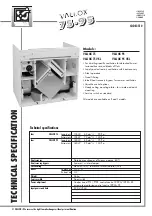
9
Problem
Fan will not start.
Fan sounds
noisy.
Solution
1.Check circuit fuses or breakers.
2. Check line wire connections to the fan and switch wire connections
in the switch housing.
CAUTION:
Make sure main power is off.
1. Make sure all motor housing screws are snug.
2. Make sure the screws that attach the fan blade bracket to the motor
hub is tight.
3. Make sure wire nut connections are not rubbing against each other
or the interior wall of the switch housing.
CAUTION:
Make sure main power is off.
4. Allow a 24-hour "breaking-in" period. Most noise associated with a
new fan disappear during this time.
5. If using an optional light kit, make sure the screws securing the
glassware are tight. Check that light bulb is also secure.
6. Some fan motors are sensitive to signals from solid-state variable
speed controls.
If you have installed this type of control, choose and install another
type of control.
7. Make sure the upper canopy is a short distance from the ceiling. It
should not touch the ceiling.
13. TROUBLESHOOTING
PERFORMANCE
AND ENERGY
INFORMATION
Ceiling fan airflow is measured in cubic feet per minute (CFM).
Power use is measured in watts. To maximize energy savings:
Choose a fan with high airflow efficiency (CFM/watt).
Use ENERGY STAR -labeled lighting in your fan.
Remember to switch off your fan when you leave the room.
*Measured according
to the ENERGY STAR
approved Solid State
test method
FAN SPEED
Low
Medium
High
FAN POWER CONSUMPTION
(watts)
69.16
34.73
9.52
AIRFLOW EFFICIENCY
(CFM/watt)
89.86
121.18
171.84
AIRFLOW
(CFM)*
6214.63
4208.55
1635.93
Money Isn't All You're Savin
R
R




























